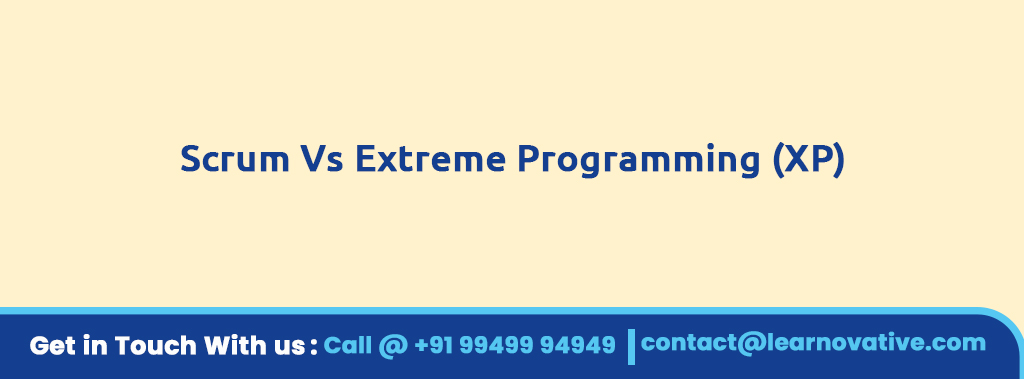
Scrum and Extreme Programming (XP) are both agile frameworks that share some common principles, but they differ in practices, focus, and implementation. Here’s a breakdown of the key differences:
1. Focus and Practices:
- Scrum:
- Focuses on managing the development process and providing a framework for delivering incremental product features through time-boxed Sprints.
- Does not prescribe specific engineering or coding and technical practices.
- Emphasizes accountabilities, events, Values and artifacts to ensure product delivery through iterative and incremental approach.
- Extreme Programming (XP):
- Primarily focused on improving software engineering practices.
- Introduces several specific technical practices, such as pair programming, test-driven development (TDD), continuous integration, refactoring, and coding standards.
- Aims for high-quality code and frequent, small releases to improve responsiveness to changing requirements.
2. Iterations and Timebox:
- Scrum:
- Uses Sprints, typically less than or equal to one month long, to deliver increments of the product.
- Sprint length is usually fixed, and each Sprint contains Sprint Planning, Daily Scrum, Sprint Review and Retrospective.
- XP:
- Favors shorter iterations (often 1-2 weeks) and advocates for frequent, even daily releases if possible.
- More flexible with iteration length and aims for continuous feedback and incremental releases at a faster pace.
3. Roles:
- Scrum:
- Defines specific accountabilities: Product Owner, Scrum Master, and Developers.
- Each accountability has clear rights and responsibilities.
- XP:
- Has roles like Coach, Customer, Programmer, and Tester, but the focus is more on collaboration and technical excellence.
- XP teams tend to be less structured in terms of hierarchical roles compared to Scrum.
4. Customer Involvement:
- Scrum:
- The Product Owner represents the customer and stakeholders, managing the Product Backlog and ensuring that the team is working on the highest-value items.
- Direct customer involvement is less frequent, typically happening during the Sprint Reviews.
- XP:
- Customer involvement is continuous. The Customer (or representative) is actively involved with the development team on a daily basis, providing constant feedback, helping define features (user stories), and making decisions about priority and scope.
5. Engineering Practices:
- Scrum:
- Does not prescribe any specific engineering practices, leaving it up to the team to determine how best to develop the product increment.
- XP:
- Provides detailed guidance on 12 software engineering practices, some of them including:
- Test-Driven Development (TDD): Writing tests before writing the actual code.
- Pair Programming: Two developers work together at one workstation.
- Continuous Integration: Frequent integration of code to detect errors early.
- Refactoring: Continuous improvement of the codebase without changing its behavior.
- Simple Design: Keeping the design as simple as possible to meet current requirements.
- Provides detailed guidance on 12 software engineering practices, some of them including:
6. Flexibility in Requirements:
- Scrum:
- Requirements are captured in the Product Backlog, and the team commits to a set of items during each Sprint.
- Once a Sprint starts, the scope is locked for the duration of the Sprint as long as the Sprint Goal is not endangered.
- XP:
- Requirements are captured in user stories and can change at any time.
- XP is more flexible with requirements changes and encourages adapting to new information, even during iterations.
7. Testing Approach:
- Scrum:
- Testing is an integral part of delivering a “Done” increment, but Scrum does not specify when or how testing is done.
- Testing practices and schedules are defined in the “Definition of Done”.
- XP:
- Test-driven development (TDD) is a core practice, meaning tests are written before code, and automated tests are run frequently to ensure the system remains stable.
- Testing is continuous, and every new feature must pass its tests before it can be considered complete.
8. Release Frequency:
- Scrum:
- Releases typically happen at the end of a Sprint (although they can occur more frequently), but this depends on whether the Increment is deemed ready and shippable.
- XP:
- Promotes small, frequent releases. Ideally, XP teams strive to release working software as frequently as possible, sometimes even multiple times per day.
9. Planning and Estimation:
- Scrum:
- Uses Sprint Planning to decide the Sprint Goal and what work will be done during a Sprint to achieve that goal. The Developers commit to specific Product Backlog items.
- Estimation is done in terms of Story Points or another unit of measure that reflects effort, uncertainty and complexity.
- XP:
- Planning is more fluid, with the team focusing on short iterations and deciding which user stories to tackle based on their priority and effort.
- XP uses story points and ideal days for estimation, but emphasizes constant adjustment based on progress.
10. Cultural Emphasis:
- Scrum:
- Emphasizes empiricism (transparency, inspection, adaptation), collaboration, and self-organization and Cross-functionality of the Scrum Team.
- A framework primarily focused on people, practices, process and product improvement through regular inspection and adaptation.
- XP:
- Focuses heavily on the quality of the code and the developer experience. It prioritizes technical excellence and creates a sustainable development pace through best engineering practices.
- There’s a stronger focus on the engineering culture and constant refactoring of the code to keep it clean.
Summary of Key Differences:
Aspect | Scrum | Extreme Programming (XP) |
Focus | Process and management framework | Software engineering practices |
Roles/Accountabilities | Defined (Scrum Master, Product Owner, Developers) | Less formal, but includes roles like Programmer, Customer |
Applicability | Software and non-software also | Software only |
Iteration Length | <= one month | 1 – 2 weeks |
Engineering practices | Not defined | Based on 12 engineering practices |
Customer involvement | Through Product Owner and Developers meet Stakeholders during Sprint Review and occasionally | Direct and more frequent |
Requirements | Fixed during the Sprint keeping the Sprint Goal into consideration | Flexible even within the iteration they can change |
Both frameworks aim to improve collaboration, transparency, and product delivery, but XP focuses more on engineering discipline and technical quality, while Scrum emphasizes process management and team dynamics. Some organizations blend elements of both frameworks to optimize their agile practices.
So instead of thinking whether Scrum to be used or Extreme Programming, consider Scrum with selected Extreme Programming practices. It will make Scrum even more effective.
To understand more insights of Scrum, Extreme Programming and other Agile frameworks, join Learnovative’s A-CSM certification training in Hyderabad. You will get a deeper understanding of various Agile frameworks with similarities, differences and applicability of those frameworks in various domains.

